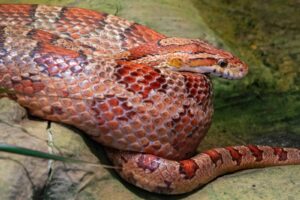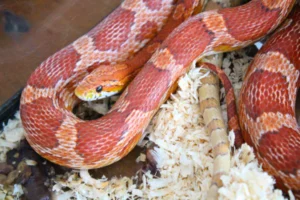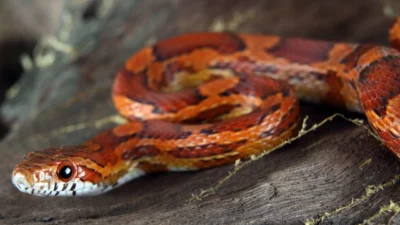Corn snakes, beloved for their vibrant patterns and gentle disposition, captivate reptile enthusiasts worldwide. As individuals consider welcoming these serpentine companions into their homes, a fundamental question arises: How long do corn snakes live in captivity?
Corn snakes, when properly cared for in captivity, can live for an impressive span of 15 to 23 years on average. However, with exceptional care and genetics, some individuals have been known to exceed these expectations, living well into their twenties.
The longevity of corn snakes in captivity is influenced by various factors, including diet, habitat conditions, genetics, and overall health maintenance. Providing a suitable environment, a balanced diet, regular veterinary check-ups, and attentive care are essential for maximizing the lifespan of these captivating serpents.
How long do corn snakes live in captivity

Corn snakes typically live for about 15 to 20 years in captivity, although some individuals can live even longer with proper care. There are several factors that contribute to their longevity in captivity:
- Proper Housing: Providing an appropriate habitat is crucial for the health and well-being of corn snakes. This includes a secure enclosure with adequate space for movement, hiding spots, substrate for burrowing, and a temperature gradient to allow for thermoregulation.
- Nutrition: Feeding a balanced diet is essential for maintaining the health of corn snakes. They are carnivorous and primarily eat rodents such as mice and rats. Offering appropriately sized prey and ensuring a varied diet can help prevent nutritional deficiencies.
- Hydration: Access to clean water is necessary for hydration, shedding, and overall health. Fresh water should be provided in a shallow dish and changed regularly to prevent contamination.
- Environmental Conditions: Corn snakes require specific environmental conditions to thrive. This includes maintaining proper humidity levels, temperature gradients, and photoperiods that mimic their natural habitat.
- Veterinary Care: Regular health check-ups with a reptile veterinarian can help identify and address any health issues early on. Preventive measures such as parasite control and vaccinations can contribute to a longer lifespan.
- Handling: Gentle and appropriate handling can help reduce stress and build trust between the snake and its owner. Avoiding rough handling and providing opportunities for exercise outside of the enclosure can contribute to the snake’s overall well-being.
By ensuring these factors are met, snake keepers can help maximize the lifespan of their corn snakes in captivity. Additionally, providing enrichment activities such as climbing branches and hiding spots can help stimulate their natural behaviors and promote a healthy lifestyle.
Care Requirements for Longevity
For promoting the longevity of corn snakes in captivity, it’s essential to ensure their care requirements are met consistently. Here’s a breakdown:
- Enclosure: Provide a spacious enclosure with secure lids to prevent escape. A 20-gallon tank is suitable for adult corn snakes. Ensure good ventilation and include hiding spots and climbing structures.
- Temperature: Maintain a temperature gradient of 75-85°F (24-29°C) on the cooler side and 85-90°F (29-32°C) on the warmer side. Use heat mats or ceramic heat emitters for heating, and include a thermostat to regulate temperatures.
- Humidity: Maintain moderate humidity levels of 40-60%. Mist the enclosure as needed, especially during shedding periods, and provide a humid hide with moistened substrate.
- Substrate: Use safe substrates such as aspen shavings, cypress mulch, or paper towels. Avoid substrates that can cause impaction, such as sand or cedar shavings.
- Feeding: Offer appropriately sized prey items, typically mice or rats, every 7-10 days for juveniles and every 10-14 days for adults. Adjust feeding frequency based on the snake’s age, size, and activity level.
- Water: Provide fresh, clean water in a shallow dish at all times. Ensure the dish is large enough for soaking, as corn snakes may soak to aid in shedding or hydration.
- Handling: Handle your snake gently and avoid excessive handling, especially before and after feeding. Wash your hands before and after handling to prevent the spread of bacteria.
- Health Monitoring: Monitor your snake’s behavior, appetite, and appearance regularly. Look out for signs of illness, such as lethargy, weight loss, respiratory issues, or abnormal shedding.
- Veterinary Care: Schedule annual check-ups with a reptile veterinarian and seek veterinary care promptly if you notice any health concerns. Follow their recommendations for vaccinations, parasite prevention, and treatment.
- Enrichment: Provide environmental enrichment such as branches, rocks, and foliage for climbing and hiding. Rotate and change enrichment items regularly to prevent boredom.
- Cleanliness: Spot clean the enclosure daily and perform a thorough clean-out every few weeks. Disinfect the enclosure and accessories regularly to prevent the spread of pathogens.
By consistently meeting these care requirements and providing a suitable environment for your corn snake, you can help ensure its long and healthy life in captivity.
Comparison of wild vs. captive lifespan

In the wild, corn snakes face numerous challenges that can affect their lifespan compared to those in captivity. Here’s a comparison:
Wild Corn Snakes:
- Predation: In their natural habitat, corn snakes face predation from a variety of animals, including birds of prey, mammals, and other snakes. Predation is a significant factor that can shorten their lifespan.
- Disease and Parasites: Wild corn snakes are exposed to various diseases and parasites, which can weaken their health and shorten their lifespan. They may also suffer injuries from encounters with other animals or environmental hazards.
- Environmental Factors: Wild corn snakes must contend with fluctuations in environmental conditions, such as temperature extremes, drought, flooding, and habitat destruction. These factors can impact their ability to find food, shelter, and mates, affecting their overall health and longevity.
- Reproduction: Reproduction in the wild can be energetically demanding and risky for female corn snakes, particularly during the breeding season. The process of finding a mate, mating, and laying eggs or giving birth can put additional stress on their bodies, potentially affecting their lifespan.
Captive Corn Snakes:
- Protection from Predators: Captive corn snakes are protected from predation, providing them with a safer environment compared to their wild counterparts. This significantly reduces the risk of premature death due to predation.
- Consistent Food Supply: In captivity, corn snakes are provided with a steady and varied diet of appropriately sized prey items, reducing the risk of starvation or malnutrition. This consistent food supply contributes to their overall health and longevity.
- Controlled Environment: Captive corn snakes benefit from a controlled environment where temperature, humidity, and other environmental factors can be carefully monitored and adjusted as needed. This helps prevent stress-related illnesses and ensures optimal conditions for their well-being.
- Veterinary Care: Captive corn snakes have access to veterinary care, allowing for early detection and treatment of health issues. Regular check-ups, vaccinations, and parasite control measures can help maintain their health and extend their lifespan.
Overall, captive corn snakes tend to live longer, healthier lives compared to their wild counterparts due to reduced exposure to environmental hazards, predation, and disease. With proper care and attention to their needs, captive corn snakes can often live well beyond their wild counterparts’ average lifespan.
Tips for Promoting Longevity
Promoting longevity in corn snakes, as with any other pet, involves providing proper care and attention to their physical and mental well-being. Here are some tips:
- Proper Housing: Ensure the snake’s enclosure is spacious enough for it to move around comfortably. Provide hiding spots and substrate for burrowing, as well as branches or other climbing structures for enrichment.
- Temperature and Humidity: Maintain appropriate temperature gradients and humidity levels in the enclosure. Corn snakes require a thermal gradient to regulate their body temperature effectively, as well as moderate humidity to aid in shedding and respiratory health.
- Nutrition: Feed your corn snake a varied diet of appropriately sized prey items. Monitor their feeding habits and adjust the size and frequency of meals as needed. Consider offering frozen-thawed prey to minimize the risk of injury and disease transmission.
- Hydration: Always provide access to clean, fresh water. Ensure the water dish is large enough for the snake to soak in if desired, especially during shedding periods. Regularly clean and refill the water dish to prevent contamination.
- Handling: Handle your corn snake gently and responsibly, minimizing stress and avoiding rough handling. Allow the snake to explore outside of its enclosure in a safe and supervised environment, but be mindful of potential hazards.
- Veterinary Care: Schedule regular check-ups with a reptile veterinarian to monitor your snake’s health and address any concerns promptly. Stay up-to-date on vaccinations and parasite control to prevent illness.
- Environmental Enrichment: Provide enrichment opportunities such as climbing structures, hiding places, and novel objects to stimulate your snake’s natural behaviors and prevent boredom.
- Cleanliness: Maintain a clean enclosure by regularly spot-cleaning waste and debris, and performing thorough cleanings as needed. This helps prevent the buildup of harmful bacteria and parasites.
- Observation: Monitor your snake’s behavior, appetite, and appearance regularly for any signs of illness or distress. Early detection and intervention can often prevent more serious health issues.
- Research and Education: Continuously educate yourself about corn snake care and behavior to provide the best possible care for your pet. Stay informed about new developments and advancements in reptile husbandry.
By following these tips and providing attentive care, you can help promote a long and healthy life for your corn snake in captivity.
Conclusion
On this page, you can learn how long do corn snakes live in captivity. Corn snakes typically live for about 15 to 20 years in captivity. With proper care, attention to their needs, and a controlled environment, captive corn snakes can enjoy longer and healthier lives compared to their wild counterparts.

